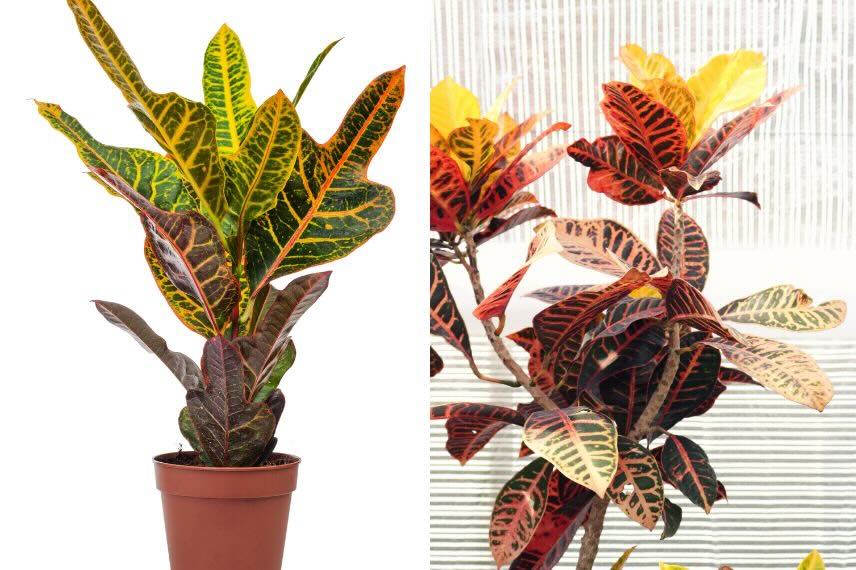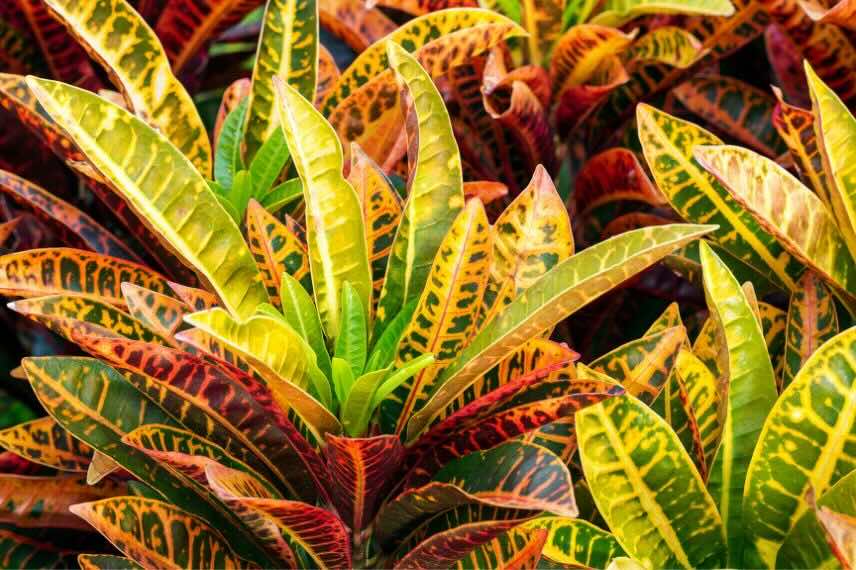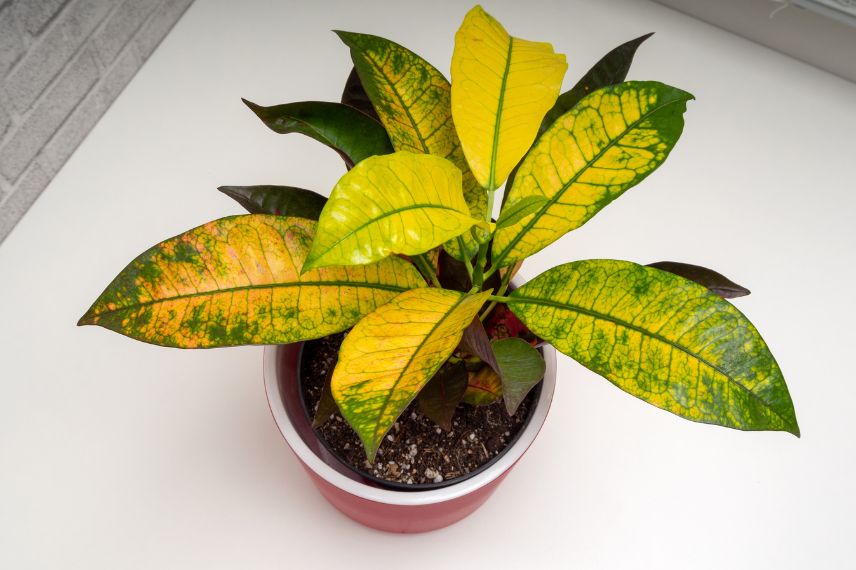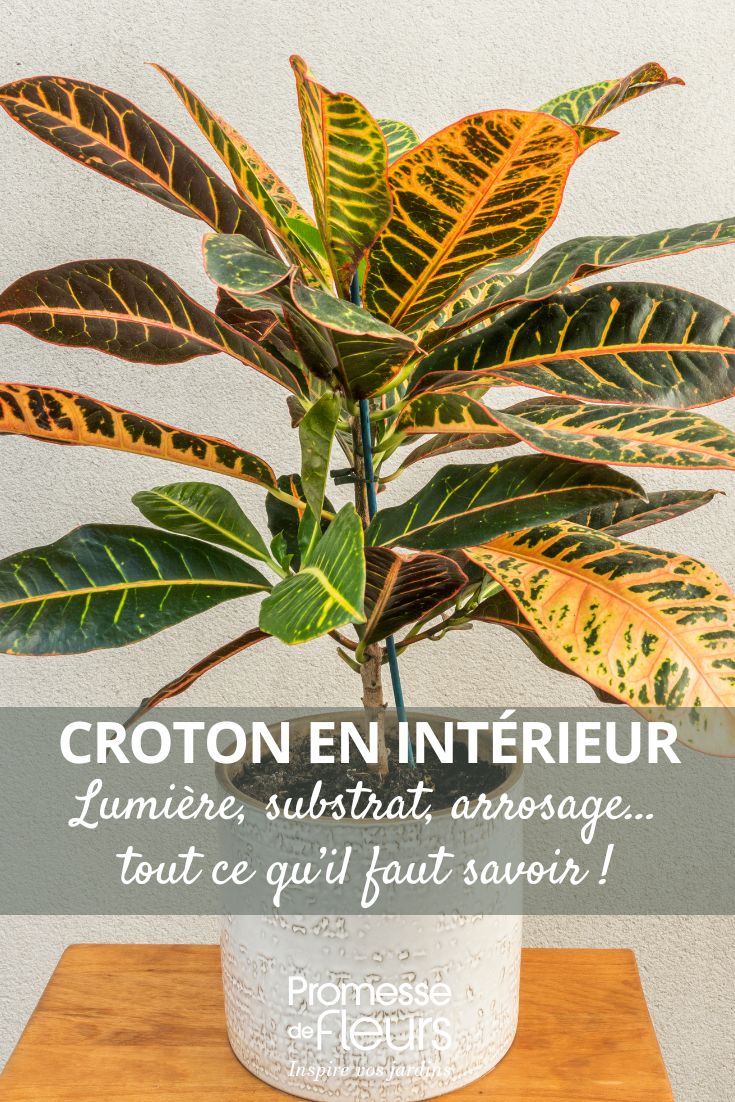
Croton: Caring for This Houseplant Through the Seasons
For a healthy indoor plant
Contents
The Croton (Codiaeum variegatum) catches every eye with its vibrant, variegated foliage in shades of red, green, yellow or orange. Native to tropical regions, it brings a real splash of colour to indoor spaces, provided its natural rhythm is respected.
Because beneath its flamboyant appearance, the croton requires minimal attention to stay in top condition. Too much water, insufficient light, a cold draught… and it starts dropping its leaves without warning. The key to keeping it beautiful and healthy all year round? Adapting care with each season.
Light, watering, temperature, fertiliser, humidity: discover our advice for caring for your croton month after month, and long enjoy its tropical beauty indoors.
In spring: the revival
The croton slowly resumes its growth with the arrival of fine weather. At this time, you need to adjust its care to support it without shocking it. This is an important phase to lay the foundations for a beautiful season of colourful foliage.
Bright light, gentle sun
The Croton loves bright light, and just a little direct sunlight. In spring, it appreciates a very bright position with morning or late afternoon sun: this way, it boosts leaf colouration without risking scorching. A spot in front of a south-east or south-west facing window, with a light curtain for the hours when the sun is strongest, is perfect.
Resume watering, without excess
With the return of growth, water needs increase, but gradually. There’s no need to flood the plant. Wait until the top few centimetres of compost are dry before watering. Always use water at room temperature, and most importantly, empty the saucer after watering to avoid waterlogged roots.
A little fertiliser to support recovery
As soon as the plant produces new leaves, you can start feeding it. A liquid fertiliser for green plants, diluted and applied once a month, is more than enough. This will strengthen growth and particularly intensify the beautiful colours of the foliage.
The right time to repot
If the Croton seems cramped, if roots are coming out of the pot or if the compost looks tired, spring is the ideal time to repot. Use a mix of quality compost and perlite to aerate the substrate well. The new pot should be just slightly larger than the old one, with drainage holes.
Cleaning and pruning
Spring is also a good time to refresh the plant. Cut off dry leaves, clean the stems, and you can wipe the leaves with a soft, damp cloth. Don’t hesitate to prune your Croton to guide its shape and make it bushier. Turning the pot slightly every two weeks also helps balance growth throughout the season.

If the Croton when purchased resembles the left-hand photo, it may develop a more stretched and unruly habit as it grows. To maintain a compact shape, it’s necessary to prune it in spring, when growth resumes
Read also
Croton: planting, growing, and careIn summer: beware of heat and humidity
Summer is a period of active growth for the croton, but also a time when the plant can quickly become stressed by heat, dry air or inappropriate watering. The idea: support its momentum without overwhelming it.
Light: bright but filtered
In summer, the sun becomes stronger and can burn the delicate leaves of the croton if exposed directly, especially during the hottest hours. Maintain bright light, but diffused: a sheer curtain or slightly set back from a window. If the light is too weak, its colours will fade, so finding the right balance is key.
Regular but measured watering
With the heat, the growing medium dries out faster. The croton prefers its soil to stay slightly moist, without being waterlogged. Water only when the top few centimetres feel dry to the touch. In very hot weather, this may be every 2 to 3 days.
Monitor ambient humidity
The croton is a tropical plant, and the dry air in homes during summer (due to air conditioning or intense sunlight) can weaken it. An ambient humidity of around 50 to 70% suits it very well. If the air is too dry, grouping several plants together can create a more humid microclimate, or using a humidifier may help.
Misting is optional: it can provide temporary relief but isn’t essential. Above all, avoid wetting the foliage too often if the plant shows spots or if there’s poor air circulation.
Watch out for pests
Heat and dry air = the perfect combo for spider mites. The croton is particularly susceptible, especially in summer. Check the undersides of leaves (for fine webbing or tiny red dots), as well as signs of scale insects or aphids. If in doubt, a lukewarm shower or a gentle treatment with organic black soap may suffice.
Limit changes in location
In summer, the croton can react quickly to sudden moves, drafts, or overly strong light. It’s best to leave it undisturbed once it has found a stable, bright, and well-ventilated spot. This will prevent leaf drop due to stress, which is common in this somewhat sensitive plant.

To maintain the vibrant colours of the Croton, give it plenty of light and some gentle sunlight
In autumn: prepare the plant for slowing down
In autumn, the days grow shorter, the light declines, and the croton begins to slow its growth gently. This is a transitional period that’s best handled with care to avoid stress caused by seasonal changes.
Light: catching the last rays
The croton needs light to maintain its beautiful variegated colours, and in autumn, there’s less of it. It can be helpful to move the plant closer to a well-exposed window to maximise natural brightness. A west or south-facing exposure without curtains if the days are mild but not scorching may be suitable.
Watering: starting to ease off
With the drop in temperatures, evaporation slows down. The compost stays moist for longer, so watering should be spaced out. Keep checking the moisture level of the substrate deep down: if the top 2-3 centimetres are still damp, wait. The right rhythm is dictated by the compost, not the calendar.
Fertiliser: spacing out then stopping
In autumn, growth decreases. It’s therefore unnecessary to continue fertilising at the same rate as in spring or summer. You can gradually reduce the doses, then stop completely by the end of October. The croton won’t need any more until spring returns.
Rotating the pot for balanced growth
Even though growth slows, it doesn’t stop completely. Turning the pot a quarter turn every fortnight helps maintain a balanced habit, especially if the light becomes more directional due to shorter days.
Protecting from cold and draughts
This is a critical time: cold draughts and sudden temperature drops can cause the croton’s leaves to drop. So avoid placing it near an entrance door, a frequently opened window, or a radiator. The ideal temperature is between 18/20 and 27°C, and it shouldn’t drop below 16°C.
In winter: relative rest for the croton
In winter, the croton enters a dormant phase. Its growth slows down significantly, or even stops, and it becomes slightly more sensitive to its surroundings. This is the time to reduce care while protecting it from cold and excess.
Light: maximise brightness
With shorter days and weaker light, it’s essential to place the croton near a natural light source. A well-exposed window, without thick curtains, is ideal. If the room is dark, you can supplement with a grow lamp to maintain a minimum light intensity.
Watering: spaced out but monitored
The croton drinks very little in winter. Wait until the soil is dry for several centimetres before watering, sometimes every two or three weeks depending on room temperature. Watering should remain light: no soaking, no stagnant water in the saucer.
Protect from cold… and heat sources
The croton dislikes the cold, but it also doesn’t like radiators placed too close. Dry heat can increase leaf drop. Avoid overly exposed spots, and watch out for cold draughts near poorly insulated windows.
Humidity: dry air is its enemy
Heating dries out the surrounding air, which can weaken the croton. Ideally, maintain humidity around 50/60% when its needs are reduced.
Patience and calm
If the croton loses a few leaves, it’s not necessarily a warning sign. It may simply be pausing, like many tropical plants in winter. The most important thing is not to overcompensate with excessive watering or frequent moves. A little stability and light, and it will bounce back vigorously in spring.

If the croton loses a few leaves in winter, it’s a normal process during dormancy
- Subscribe!
- Contents
































Comments